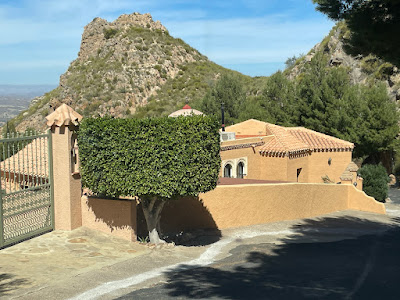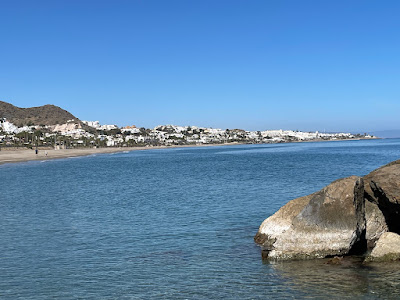Monday 13th March
Off early this morning, well early for us – 10.30am! I’m a real coward when trying to phone someone in Spain in case they don’t speak English, and I chickened out! So, we were off to Garrucha to make an appointment for Muffin to be clipped. Of course, the receptionist spoke perfect English – that will teach me ☹ From the groomers we walked northwards on the Malecon Walk. We hadn’t walked that bit before and with the sun on our backs it was lovely. We were looking for a café to have a coffee, but wanted one that had some shade and we eventually found one.
The Malecon Walk is approximately one kilometre long and has a magnificent white Macael marble railing and a floor of red and white tiles which form an interesting design.
These two photos are from our walk along the Malecon Walk.
And these two are of the Square and Town Hall.
We had a quick visit to Mercadona before returning to the villa.
The origin of Garrucha dates back to the 16th century and was founded on fishing. Today it is the second most important fishing port in Andalusia. Garrucha is famous for it’s red shrimp
During the 18th century the southern Spanish Mediterranean coast was suffering from attacks of Berber pirates. So, in 1764, Charles III of Spain ordered the construction of nine fortifications on the coast of the Kingdom of Granada. Jesús Nazareno Castle was built in 1769. It is a rectangular artillery fort with a semicircular counterguard for coastal defence and was armed with 4 cannons. Originally the entrance to the fort was over a drawbridge. It was manned by an officer, 3 corporals and 20 soldiers. In 1845 it was transferred to the Carabineros Corps and later was used by the Guardia Civil. At present it is used as a marine life museum.
Garrucha is also well known for its port where gypsum ships are loaded. The gypsum comes from the mines at Sorbas, 25 miles away. The gypsum is transported to Garrucha by lorries who hurtle through the countryside and frighten the life of poor drivers, especially the British ones who aren’t used to them!
Today was the first anniversary of the awful Calima (Saharan sand storm) that came in last year. These are just a couple of the photos I took at the time.
We decided to go up to Cabrera and try to recreate the picnic we had with Penny and Jim in 2020. However, we were not going to continue along the dirt track back to Sopalmo! We climbed up to the village of Cabrera and then on higher looking for the spot we stopped at 3 years ago. Before we found the place, we came across a picnic area, so Richard pulled in there. It appeared to be called Merendero El Chuflas and was there, I guess, as there was trail starting and finishing nearby. We sat and ate our lunch with a wonderful view in front of us.
The great thing about turning round and retracing our steps is that we really got to see the view and the amazing houses which seem to be clinging to the mountain side. These are just a few of the photos I took.
These photos were taken as we were entering the village of Cabrera.
Back at the villa we read and swam. The water is still at 28° and is lovely 😊
Wednesday 15th March
Today I was going to the Doctor to discuss my blood test results. I was quite nervous as I had no idea what she was going to say. In fact, all was fine and my white blood cells were just where they should be. However, my triglycerides are a bit high, so she has put me on a new medication.
My doctor’s appointment was at 12.30 so I missed out on lunch and we went to the ice-cream parlour, well why not!
We took Muffin on the beach and I had a paddle, the water was quite warm but certainly not warm enough to swim!
I decided to do some research on Cabrera. This was taken from Cabrera’s own website.
Perched effortlessly in the Sierra Cabrera mountain range is the exquisite, unique Moorish village of Cabrera. With its array of delightful Moorish domes and filigree arches, Cabrera is a unique community, an enchanting, welcoming little hideaway evoking the rich architectural heritage of Andalucia yet incorporating all the comforts of 21st century life. It is close to the African continent and its Moorish roots.
In the area are numerous cortijadas such as La Carrasca, Los Moralicos, Aljuezar, Jacís, Alcandía, La Adelfa, Teresa, Cova Negra, Mofar, El Dondo, Cufría or Cortetes, but most of them are depopulated and abandoned, only Cortijo Cabrera and Cortijo Grande maintain a certain population thanks to residential tourism, and El Agua Enmedio and El Sopalmo thanks to their proximity to the coast.
The word Cortijada is an expression of Andalusian origin, to designate a small nucleus of rural houses, surrounded by cultivated fields. It is typical of smallholding areas, and its origin dates back to the 18th and 19th centuries, as a consequence of the peasants' search for security and cooperation. I always thought, and this was backed up by research, that a Cortijo was a farmhouse but here they are calling a village a Cortijo. Confusing or what?























.JPG)
No comments:
Post a Comment